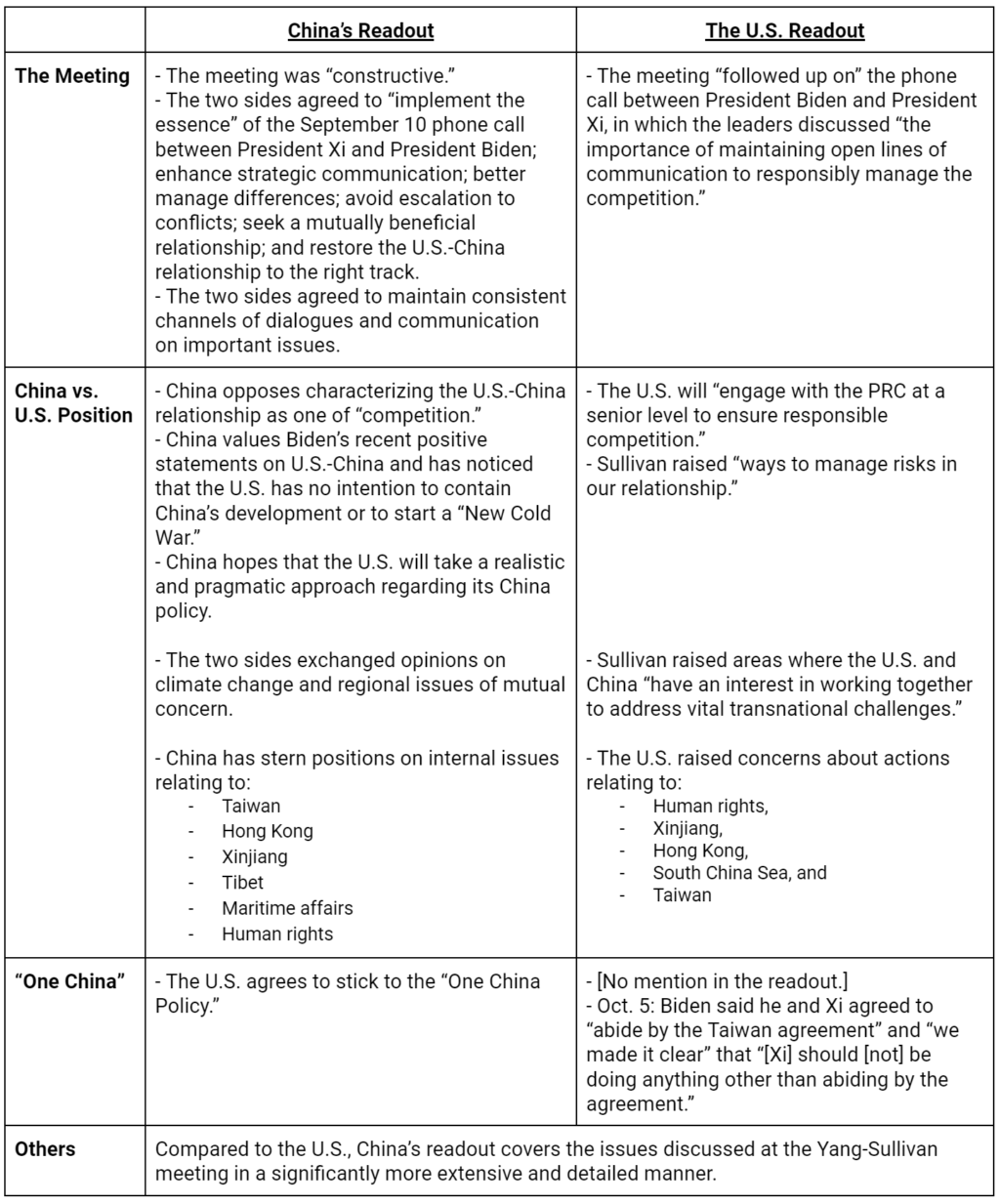
Research Associate & Manager, TnT Program

Research Assistant Intern
Cover Image: National Security Advisor Jake Sullivan and his Chinese counterpart, Yang Jiechi, in a meeting in Zurich, October 6, 2021. (Source: Chinese Ministry of Foreign Affairs)
The bilateral relationship between China and the United States has finally begun to show solid signs of improvement in recent weeks. The September 9 phone call between leaders of the two countries reaffirmed Beijing’s and Washington’s intention to prevent conflict and seek avenues for cooperation. The release of Huawei CFO Meng Wanzhou, which coincided with the release of Canada’s “two Michaels” and American citizens Victor and Cynthia Liu, became the first diplomatic thawing produced under the Biden administration. National Security Advisor Jake Sullivan’s meeting with his Chinese counterpart, Yang Jiechi, in Zurich yesterday follows this trend and reassures the world that conflict and open hostility is undesirable for both Beijing and Washington. The meeting showed an emerging trend towards ‘building back better’ U.S.-China relations through revitalized, professional senior-level diplomatic engagement after a volatile four years under the Trump administration. It also revealed various challenges and differences in the policy orientations of the U.S. and China – differences that will require continuous dialogue in order to keep both parties operating off the same page.
Although the latest Yang-Sullivan meeting did not produce any tangible outcomes to resolve pressing issues, it should be hailed as an important milestone which marks the success of the effort at continuous diplomacy on both sides of the Pacific to put the bilateral relationship back on track. Compared to their first encounter in Anchorage this March, the latest Yang-Sullivan meeting showed a relatively more focused and pragmatic diplomatic approach by both sides. Readouts were calmer and included less rhetoric directed towards their home audiences. Both China and the United States committed to maintaining open lines of communication to prevent emergencies from veering into conflict. Instead of pointing fingers at each other, the two sides engaged in constructive dialogue over specific foreign affairs issues. The White House readout reported that Sullivan “raised areas where the United States and the PRC have an interest in working together to address vital transnational challenges.” The Chinese readout said the two sides “exchanged opinions over climate change and regional issues of concern.” This sends a positive message that these two major powers are back on their feet and have chosen to responsibly pursue stable and durable coexistence.
From the furious exchange of words in Anchorage, to the cold reception meted out during Wendy Sherman’s seemingly fruitless visit to China (although in retrospect it bears noting that discussions regarding Ms. Meng Wanzhou’s release gathered momentum at the meeting) to the current stage of constructive open lines of communication, bilateral ties have steadily evolved towards the return of a more-or-less professional level of diplomatic engagement within just 10 months. Diplomats on both sides deserve credit for their incremental but continuous effort to ‘build back better’ the bilateral relationship.
One flashpoint during the Zurich meeting was that China, for the first time, sent a direct and clear response to the United States regarding Washington’s definition of the bilateral relationship . According to the Chinese readout, Yang asked his American counterpart to “recognize the mutually beneficial nature of the bilateral relationship, and correctly understand China’s domestic and foreign policy and strategic intention.” He specifically pointed out that China opposes defining the U.S.-China relationship as a competition, which the Biden administration has consistently done while drawing a cautious distinction between competition and conflict.
President Biden told his Chinese counterpart in February that the U.S. “welcome[s] the competition” but does not look for conflict. He reaffirmed the same idea during his September 9 call and made clear that the U.S. seeks to “responsibly manage the competition” between the two sides.
China has not directly opposed this rhetoric before. Its rhetoric had focused on avoiding conflict and calling for win-win cooperation. The most direct response before this meeting came from State Councillor and Foreign Minister Wang Yi’s remarks at the Council on Foreign Relations this April, in which he said that China has “no intention to compete or contend with the United States.” Even President Xi didn’t directly respond to President Biden’s rhetoric on competition during their September 9 call. The message from Yang during the Zurich meeting shows that the Chinese side has formally rejected the Biden administration’s long-standing view of the bilateral relationship. A positive takeaway is that China has begun to use the Biden administration’s own language to better communicate its position. A more negative reading is that it shows the still-considerable disagreement between Beijing and Washington over the nature and, potentially the future path, of their relationship, which may directly impact whether the two countries could produce more tangible outcomes and harvest the “low hanging fruits” as they scale up their diplomatic engagements.
Traditionally, readouts from the Chinese side are longer and more detailed compared to the American version. Furthermore, the two readouts of the Zurich meeting show a variation in emphasis, wording and even categorization of the meeting. What was missing in the text reveals the challenges inherent in squaring the different policy orientations, and which will require a lot more communication by both sides in order to restore the relationship to a more stable track.
A Comparative List of Key Points from China’s Ministry of Foreign Affairs and the U.S. State Department’s Dueling Readouts on the Yang-Sullivan Meeting

Both readouts downplayed positive tones, especially when referencing the other side. Although the Chinese side made it clear in its readout that it opposes defining the relationship as a “competition,” the American readout stated that the continuation of senior level engagement is to ensure “responsible competition.” The U.S. readout also didn’t mention that China “recognized President Biden’s recent positive statements on the U.S.-China relationship and has noticed that the U.S. has no intention to contain China’s development or to start a ‘New Cold War’.” Neither did the Chinese readout give Sullivan credit for raising areas where the two countries have shared interests, but simply put it as an exchange of opinion over climate change and regional issues. An explanation for the missing positive tones is that the two countries have to manage the rising hostility towards each other within their political establishments and among their general public. In this sense, both “Dragon Slayer” and “Wolf Warrior” sentiments could become a huge obstacle for both countries as their diplomats go about attempting to restore a professionally managed semblance of engagement.
With regard to specific issue areas that concern the bilateral relationship, the readouts also revealed different policy orientations on the two sides.
On Taiwan, while China put this issue at the very head and reaffirmed its position, the U.S. readout listed Taiwan at the very end of its list of concerns concerning China. The Chinese readout mentions that the U.S. reaffirmed its commitment to adhere to the “One China Policy,” while the U.S. readout makes no mention of it. This difference shows that China seeks to further address the Taiwan issue within the bilateral context, while the U.S. still seeks to craft a balance between the “One China Policy” and its commitments under the Taiwan Relations Act.
Amidst both pro-independence and pro-status quo voices in Taipei, China’s rising domestic calls for reunification, and the U.S. inconsistently-executed policy of strategic ambiguity, the Taiwan Straits issue has become a gunpowder keg in the U.S.-China relationship. From unconfirmed U.S. marine deployment in Taiwan, to the latest report of U.S. special operation forces in Taiwan, much needs to be discussed frankly and with clarity to get the two sides on the same page. Communication mechanisms need to be strengthened, such that the government-to-government relationship is not overshadowed or unduly affected by third party domestic and foreign policy actors. In this regard, the Yang-Sullivan meeting is a sign of initial progress towards building such a communication channel to avoid and mitigate tensions and crises caused by unexpected developments and uncertainties. What was discussed in the Yang-Sullivan meeting may also affect the potential announcement of China’s new Taiwan policy by President Xi on October 9.
On other issues, China has redoubled its positions on national security, sovereignty and territorial integrity. China put Hong Kong, Xinjiang and Tibet after Taiwan, before it mentioned maritime affairs and human rights. With a ‘shared values’-driven undertone, the U.S. put human rights as its primary concern, followed by Xinjiang, Hong Kong, and thereafter, the South China Sea and Taiwan. The different policy orientations could be a source of division during the virtual meeting between the leaders of the two countries, especially if they seek tangible outcomes before the end of the year.

The Institute for China-America Studies is an independent nonprofit, nonpartisan research organization dedicated to strengthening the understanding of U.S.-China relations through expert analysis and practical policy solutions.
1919 M St. NW Suite 310,
Washington, DC 20036
icas@chinaus-icas.org
(202) 968-0595
© 2024 INSTITUTE FOR CHINA-AMERICA STUDIES. ALL RIGHTS RESERVED.
Rebooting China’s High-Quality Growth and Development